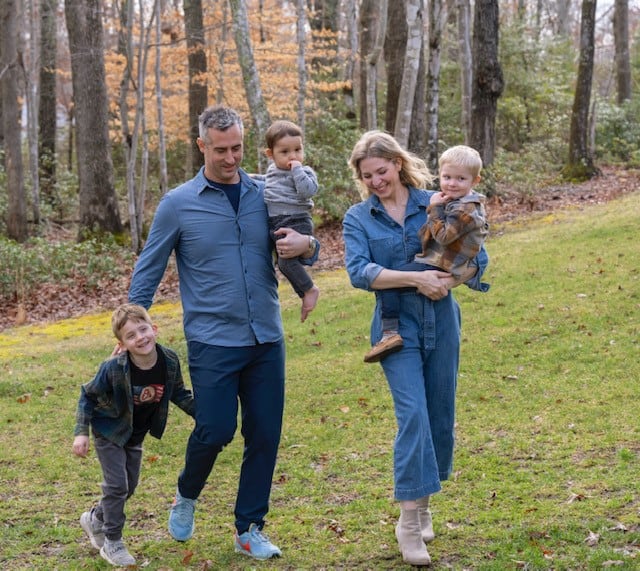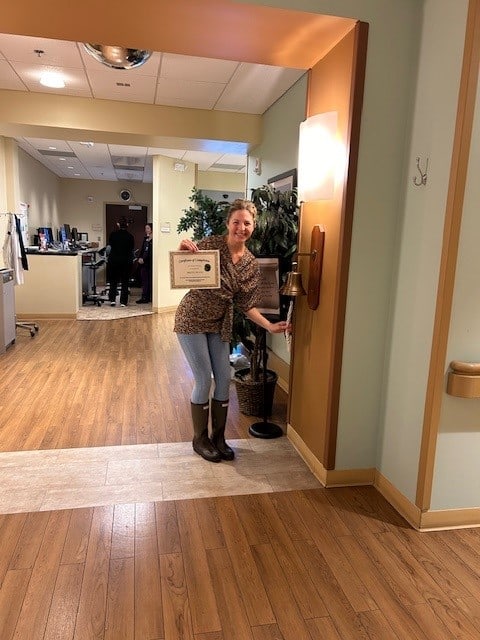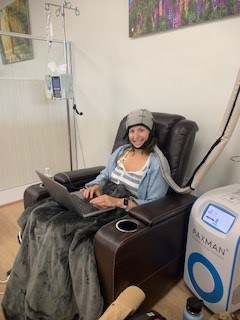
In 2023, Brett felt a lump in her breast while breastfeeding her youngest child, who was 3 months old at the time. “I initially thought it was mastitis,” she said. “And I was concerned because I wanted to keep nursing him. I breastfed my two older boys and wanted to continue doing that. I was worried I had an infection.”
Brett reached out to her OBGYN and her midwife, who said while it was probably nothing, they’d send her for a mammogram to be safe. “I was 37 at the time, so I never had a mammogram and likely wouldn’t have until I was 40,” Brett said. “I’ve always been healthy, I had no issues with childbirth. Nothing like breast cancer was on my radar.”
Brett had the mammogram and a breast ultrasound. Shortly after that, she was told she needed a biopsy. “That’s when the red flags went up. That’s when I started to get nervous,” she said. “My mom passed away from kidney cancer, so I think as soon as I realized this could be cancer, the red flags blew up.”
Biopsy Results
Four days after Brett’s 38th birthday, she got the biopsy results back. She had grade 3 triple negative ductal carcinoma in situ (DCIS). “I was in shock, but I also think I weirdly knew it was coming. I told my husband it was going to be something,” she said.
The following week, Brett met with her care team and had a port put in. “My surgeon was really open with me. She said this type of cancer is super aggressive, but with it being triple negative, she felt strongly it would respond quickly to chemotherapy,” Brett said. “Since it was only 2 centimeters, she said we could go right to surgery.”
She was nervous about the risk of infection and going into surgery while still so newly postpartum. “I already felt like this wasn’t my body and I wasn’t ready to go to surgery yet,” she said. The doctor told Brett the tumor was on the cusp between stage 1 and stage 2 and she didn’t think there was any lymph node involvement, so they could start with chemotherapy first.
Aggressive Treatment Plan
Brett and her husband met with her oncologist, who recommended she start a new regimen called KEYNOTE 522 based on Brett’s age and the type of cancer she had, triple negative DCIS. “She said we should be aggressive. She said it’s going to be hard, but she really felt like this was what we needed to do,” Brett explained. “We said ‘okay, we trust you.’ You relinquish a lot of control in the journey of chemo and breast cancer.”
A month after first feeling the lump in her breast, Brett started chemotherapy. “I was four months postpartum. Leading up to the chemo, it was a blur of nonstop pumping and breastfeeding. They told me to breastfeed as long as I could,” she said. “I was devastated that I wasn’t going to breastfeed him until he turned a year old. And I was trying to cherish the moments of being able to snuggle with him, skin to skin, before I started chemo.”


The chemotherapy was so strong that she couldn’t wash her clothes with the kids’ clothes, and she couldn’t hold the baby skin to skin. “All I could think of was not being able to hold my three little boys,” she said. “I worried I wouldn’t see my babies again, that I wouldn’t make it. Everything happened so fast. You don’t have time to think. You’re trusting the process at that point.”
Brett’s treatment for DCIS included chemotherapy, immunotherapy, radiation therapy and a lumpectomy. The KEYNOTE 522 regimen included Keytruda, Carboplatin and Taxol. After chemotherapy, Brett was supposed to continue Keytruda for eight months, but after the second dose, she started to have excruciating pain. “It was serious. My immune system was attacking everything in my body – my healthy muscles, my healthy cells,” she said. She started steroids to help her body get back to a functioning state.
Lifestyle Changes After Treatment
Now finished with treatment for DCIS, Brett has implemented lifestyle changes. She doesn’t drink alcohol or eat sugar, she focuses on whole foods and she exercises an hour every day. “I have scans and ultrasounds and blood work. I meet with my doctors,” Brett said. “We’re in this terrifying yet super hopeful state right now. The risk of recurrence for triple negative is super high in the first five years, but we’re hopeful.”
Brett moved away from the ‘why me?’ questions about her diagnosis and instead focused on what she could teach her children from this experience. “They are compassionate, they have empathy, this has made them more loving,” Brett said. “That’s a really powerful feeling for me, to see this.”
She also believes in the importance of being in tune with one’s body. “I was shocked by my triple negative DCIS diagnosis, but I’m so grateful I followed up when I felt the lump,” she said. “If I had not gotten a mammogram until I turned 40, I probably wouldn’t be here today.”
Statements and opinions expressed are that of the individual and do not express the views or opinions of Susan G. Komen. This information is being provided for educational purposes only and is not to be construed as medical advice. Persons with breast cancer should consult their health care provider with specific questions or concerns about their treatment.



